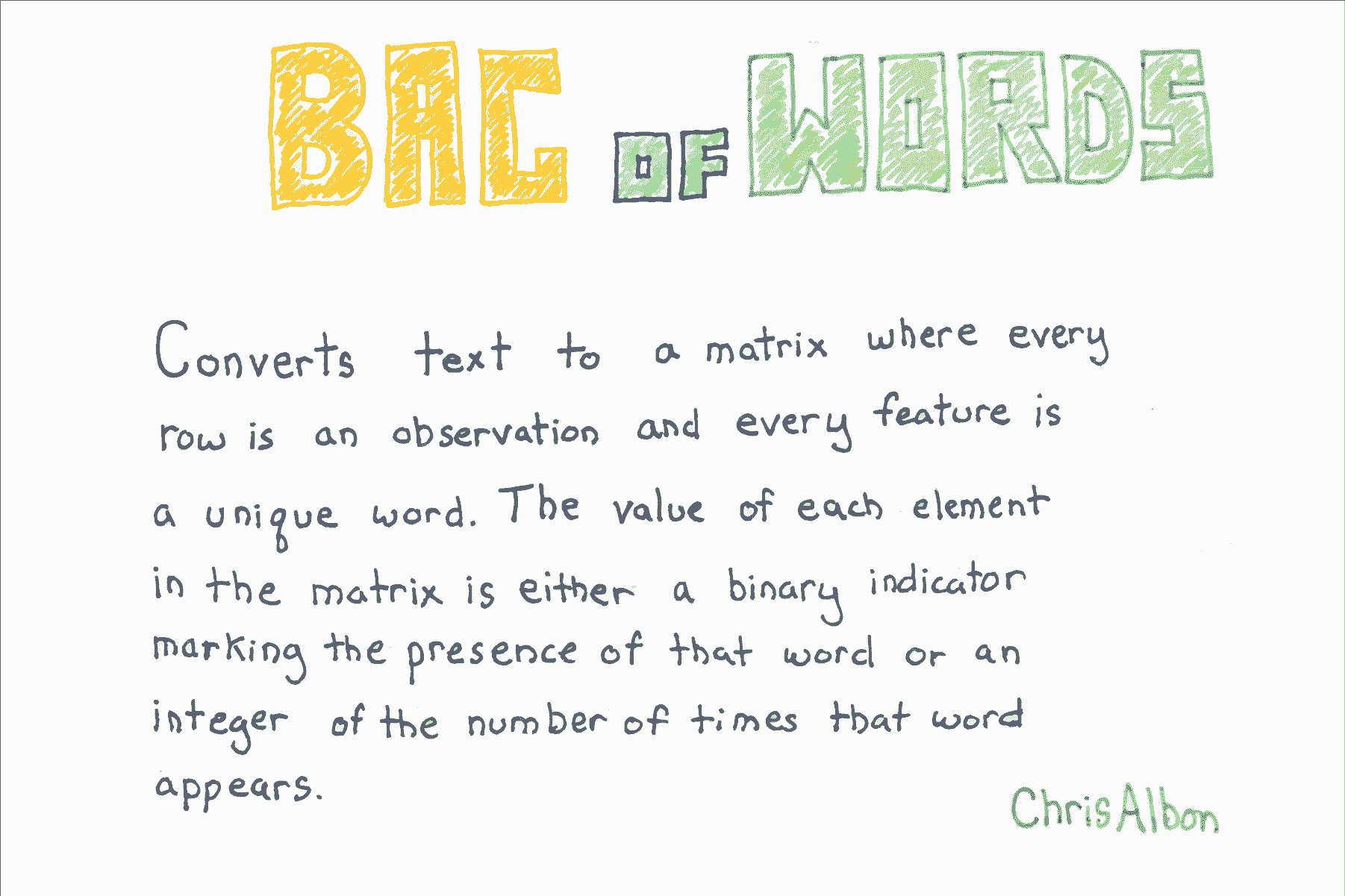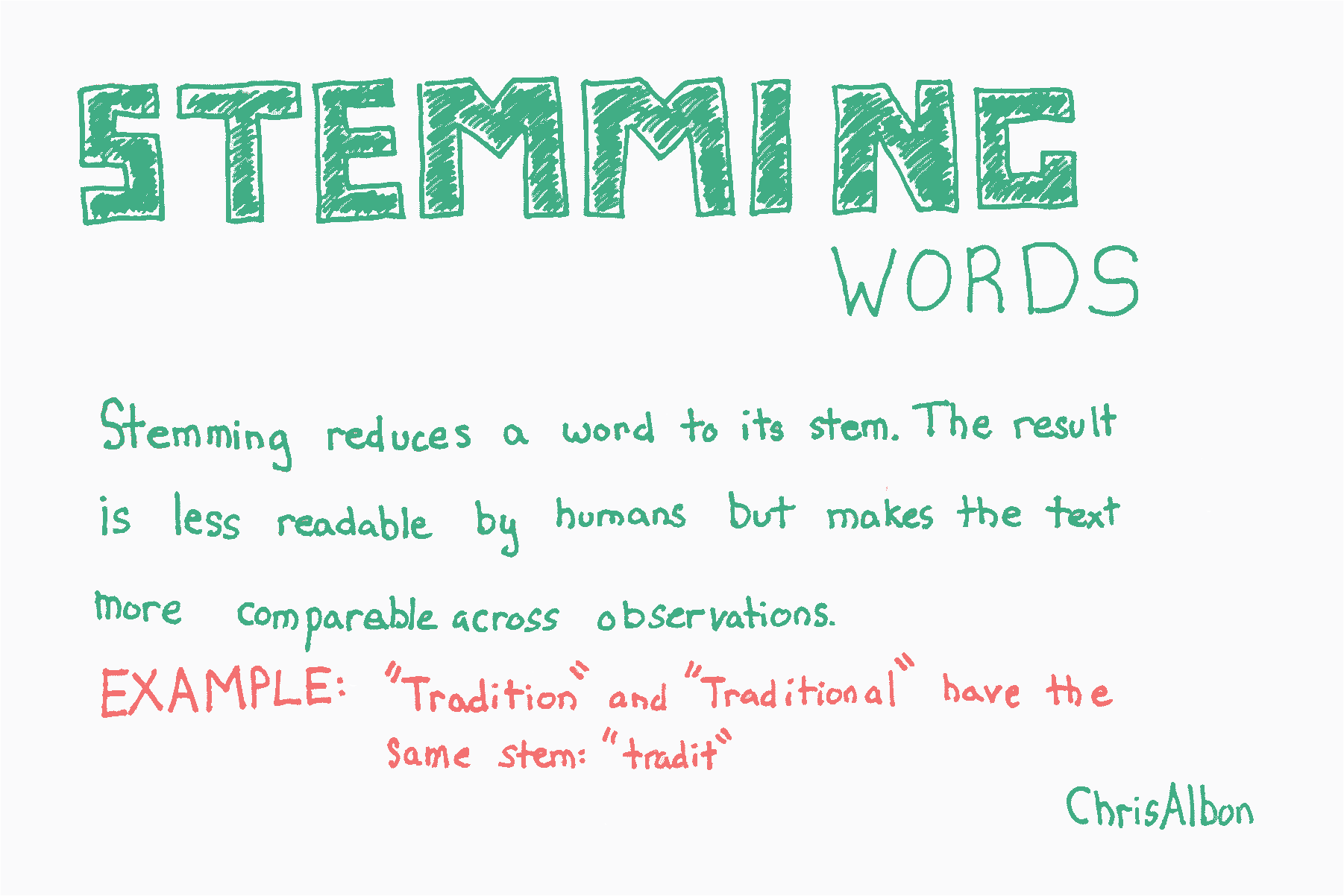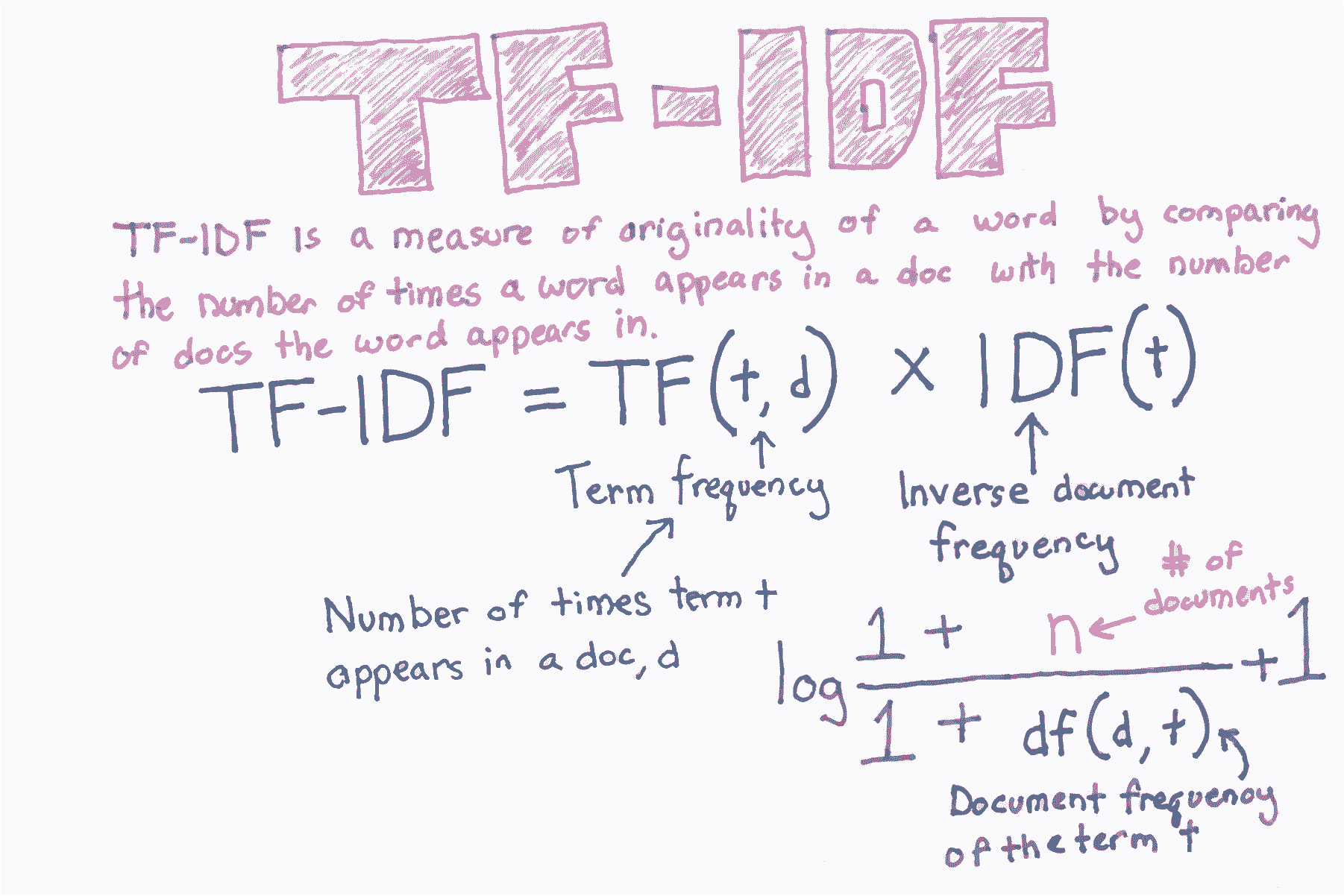# 五、文本預處理
> 作者:[Chris Albon](https://chrisalbon.com/)
>
> 譯者:[飛龍](https://github.com/wizardforcel)
>
> 協議:[CC BY-NC-SA 4.0](http://creativecommons.org/licenses/by-nc-sa/4.0/)
## 詞袋

```py
# 加載庫
import numpy as np
from sklearn.feature_extraction.text import CountVectorizer
import pandas as pd
# 創建文本
text_data = np.array(['I love Brazil. Brazil!',
'Sweden is best',
'Germany beats both'])
# 創建詞袋特征矩陣
count = CountVectorizer()
bag_of_words = count.fit_transform(text_data)
# 展示特征矩陣
bag_of_words.toarray()
'''
array([[0, 0, 0, 2, 0, 0, 1, 0],
[0, 1, 0, 0, 0, 1, 0, 1],
[1, 0, 1, 0, 1, 0, 0, 0]], dtype=int64)
'''
# 獲取特征名稱
feature_names = count.get_feature_names()
# 查看特征名稱
feature_names
# ['beats', 'best', 'both', 'brazil', 'germany', 'is', 'love', 'sweden']
# 創建數據幀
pd.DataFrame(bag_of_words.toarray(), columns=feature_names)
```
| | beats | best | both | brazil | germany | is | love | sweden |
| --- | --- | --- | --- | --- | --- | --- | --- | --- |
| 0 | 0 | 0 | 0 | 2 | 0 | 0 | 1 | 0 |
| 1 | 0 | 1 | 0 | 0 | 0 | 1 | 0 | 1 |
| 2 | 1 | 0 | 1 | 0 | 1 | 0 | 0 | 0 |
## 解析 HTML
```py
# 加載庫
from bs4 import BeautifulSoup
# 創建一些 HTML 代碼
html = "<div class='full_name'><span style='font-weight:bold'>Masego</span> Azra</div>"
# 解析 html
soup = BeautifulSoup(html, "lxml")
# 尋找帶有 "full_name" 類的 <div>,展示文本
soup.find("div", { "class" : "full_name" }).text
# 'Masego Azra'
```
## 移除標點
```py
# 加載庫
import string
import numpy as np
# 創建文本
text_data = ['Hi!!!! I. Love. This. Song....',
'10000% Agree!!!! #LoveIT',
'Right?!?!']
# 創建函數,使用 string.punctuation 移除所有標點
def remove_punctuation(sentence: str) -> str:
return sentence.translate(str.maketrans('', '', string.punctuation))
# 應用函數
[remove_punctuation(sentence) for sentence in text_data]
# ['Hi I Love This Song', '10000 Agree LoveIT', 'Right']
```
## 移除停止詞
```py
# 加載庫
from nltk.corpus import stopwords
# 你第一次需要下載停止詞的集合
import nltk
nltk.download('stopwords')
'''
[nltk_data] Downloading package stopwords to
[nltk_data] /Users/chrisalbon/nltk_data...
[nltk_data] Package stopwords is already up-to-date!
True
'''
# 創建單詞標記
tokenized_words = ['i', 'am', 'going', 'to', 'go', 'to', 'the', 'store', 'and', 'park']
# 加載停止詞
stop_words = stopwords.words('english')
# 展示停止詞
stop_words[:5]
# ['i', 'me', 'my', 'myself', 'we']
# 移除停止詞
[word for word in tokenized_words if word not in stop_words]
# ['going', 'go', 'store', 'park']
```
## 替換字符
```py
# 導入庫
import re
# 創建文本
text_data = ['Interrobang. By Aishwarya Henriette',
'Parking And Going. By Karl Gautier',
'Today Is The night. By Jarek Prakash']
# 移除句號
remove_periods = [string.replace('.', '') for string in text_data]
# 展示文本
remove_periods
'''
['Interrobang By Aishwarya Henriette',
'Parking And Going By Karl Gautier',
'Today Is The night By Jarek Prakash']
'''
# 創建函數
def replace_letters_with_X(string: str) -> str:
return re.sub(r'[a-zA-Z]', 'X', string)
# 應用函數
[replace_letters_with_X(string) for string in remove_periods]
'''
['XXXXXXXXXXX XX XXXXXXXXX XXXXXXXXX',
'XXXXXXX XXX XXXXX XX XXXX XXXXXXX',
'XXXXX XX XXX XXXXX XX XXXXX XXXXXXX']
'''
```
## 詞干提取

```py
# 加載庫
from nltk.stem.porter import PorterStemmer
# 創建單詞標記
tokenized_words = ['i', 'am', 'humbled', 'by', 'this', 'traditional', 'meeting']
```
詞干提取通過識別和刪除詞綴(例如動名詞)同時保持詞的根本意義,將詞語簡化為詞干。 NLTK 的`PorterStemmer`實現了廣泛使用的 Porter 詞干算法。
```py
# 創建提取器
porter = PorterStemmer()
# 應用提取器
[porter.stem(word) for word in tokenized_words]
# ['i', 'am', 'humbl', 'by', 'thi', 'tradit', 'meet']
```
## 移除空白
```py
# 創建文本
text_data = [' Interrobang. By Aishwarya Henriette ',
'Parking And Going. By Karl Gautier',
' Today Is The night. By Jarek Prakash ']
# 移除空白
strip_whitespace = [string.strip() for string in text_data]
# 展示文本
strip_whitespace
'''
['Interrobang. By Aishwarya Henriette',
'Parking And Going. By Karl Gautier',
'Today Is The night. By Jarek Prakash']
'''
```
## 詞性標簽
```py
# 加載庫
from nltk import pos_tag
from nltk import word_tokenize
# 創建文本
text_data = "Chris loved outdoor running"
# 使用預訓練的詞性標注器
text_tagged = pos_tag(word_tokenize(text_data))
# 展示詞性
text_tagged
# [('Chris', 'NNP'), ('loved', 'VBD'), ('outdoor', 'RP'), ('running', 'VBG')]
```
輸出是一個元組列表,包含單詞和詞性的標記。 NLTK 使用 Penn Treebank 詞性標簽。
| 標簽 | 詞性 |
| --- | --- |
| NNP | 專有名詞,單數 |
| NN | 名詞,單數或集體 |
| RB | 副詞 |
| VBD | 動詞,過去式 |
| VBG | 動詞,動名詞或現在分詞 |
| JJ | 形容詞 |
| PRP | 人稱代詞 |
## TF-IDF

```py
# 加載庫
import numpy as np
from sklearn.feature_extraction.text import TfidfVectorizer
import pandas as pd
# 創建文本
text_data = np.array(['I love Brazil. Brazil!',
'Sweden is best',
'Germany beats both'])
# 創建 tf-idf 特征矩陣
tfidf = TfidfVectorizer()
feature_matrix = tfidf.fit_transform(text_data)
# 展示 tf-idf 特征矩陣
feature_matrix.toarray()
'''
array([[ 0. , 0. , 0. , 0.89442719, 0. ,
0. , 0.4472136 , 0. ],
[ 0. , 0.57735027, 0. , 0. , 0. ,
0.57735027, 0. , 0.57735027],
[ 0.57735027, 0. , 0.57735027, 0. , 0.57735027,
0. , 0. , 0. ]])
'''
# 展示 tf-idf 特征矩陣
tfidf.get_feature_names()
# ['beats', 'best', 'both', 'brazil', 'germany', 'is', 'love', 'sweden']
# 創建數據幀
pd.DataFrame(feature_matrix.toarray(), columns=tfidf.get_feature_names())
```
| | beats | best | both | brazil | germany | is | love | sweden |
| --- | --- | --- | --- | --- | --- | --- | --- | --- |
| 0 | 0.00000 | 0.00000 | 0.00000 | 0.894427 | 0.00000 | 0.00000 | 0.447214 | 0.00000 |
| 1 | 0.00000 | 0.57735 | 0.00000 | 0.000000 | 0.00000 | 0.57735 | 0.000000 | 0.57735 |
| 2 | 0.57735 | 0.00000 | 0.57735 | 0.000000 | 0.57735 | 0.00000 | 0.000000 | 0.00000 |
## 文本分詞
```py
# 加載庫
from nltk.tokenize import word_tokenize, sent_tokenize
# 創建文本
string = "The science of today is the technology of tomorrow. Tomorrow is today."
# 對文本分詞
word_tokenize(string)
'''
['The',
'science',
'of',
'today',
'is',
'the',
'technology',
'of',
'tomorrow',
'.',
'Tomorrow',
'is',
'today',
'.']
'''
# 對句子分詞
sent_tokenize(string)
# ['The science of today is the technology of tomorrow.', 'Tomorrow is today.']
```
